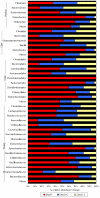The effect of dietary supplementation with spent cider yeast on the Swine distal gut microbiome
- PMID: 24130736
- PMCID: PMC3794030
- DOI: 10.1371/journal.pone.0075714
The effect of dietary supplementation with spent cider yeast on the Swine distal gut microbiome
Abstract
Background: There is an increasing need for alternatives to antibiotics for promoting animal health, given the increasing problems associated with antibiotic resistance. In this regard, we evaluated spent cider yeast as a potential probiotic for modifying the gut microbiota in weanling pigs using pyrosequencing of 16S rRNA gene libraries.
Methodology and principal findings: Piglets aged 24-26 days were assigned to one of two study groups; control (n = 12) and treatment (n = 12). The control animals were fed with a basal diet and the treatment animals were fed with basal diet in combination with cider yeast supplement (500 ml cider yeast containing ∼7.6 log CFU/ml) for 21 days. Faecal samples were collected for 16s rRNA gene compositional analysis. 16S rRNA compositional sequencing analysis of the faecal samples collected from day 0 and day 21 revealed marked differences in microbial diversity at both the phylum and genus levels between the control and treatment groups. This analysis confirmed that levels of Salmonella and Escherichia were significantly decreased in the treatment group, compared with the control (P<0.001). This data suggest a positive influence of dietary supplementation with live cider yeast on the microbial diversity of the pig distal gut.
Conclusions/significance: The effect of dietary cider yeast on porcine gut microbial communities was characterized for the first time using 16S rRNA gene compositional sequencing. Dietary cider yeast can potentially alter the gut microbiota, however such changes depend on their endogenous microbiota that causes a divergence in relative response to that given diet.
Conflict of interest statement
Figures



Similar articles
-
Effects of probiotics Pediococcus acidilactici strain MA18/5M and Saccharomyces cerevisiae subsp. boulardii strain SB-CNCM I-1079 on fecal and intestinal microbiota of nursing and weanling piglets.J Anim Sci. 2015 Nov;93(11):5313-26. doi: 10.2527/jas.2015-9190. J Anim Sci. 2015. PMID: 26641051 Clinical Trial.
-
Dietary live yeast and increased water temperature influence the gut microbiota of rainbow trout.J Appl Microbiol. 2018 Jun;124(6):1377-1392. doi: 10.1111/jam.13738. Epub 2018 Mar 12. J Appl Microbiol. 2018. PMID: 29464844
-
Temporal analysis of the effect of extruded flaxseed on the swine gut microbiota.Can J Microbiol. 2014 Oct;60(10):649-59. doi: 10.1139/cjm-2014-0317. Epub 2014 Sep 3. Can J Microbiol. 2014. PMID: 25264709
-
Changes in the Ileal, but Not Fecal, Microbiome in Response to Increased Dietary Protein Level and Enterotoxigenic Escherichia coli Exposure in Pigs.Appl Environ Microbiol. 2019 Sep 17;85(19):e01252-19. doi: 10.1128/AEM.01252-19. Print 2019 Oct 1. Appl Environ Microbiol. 2019. PMID: 31324635 Free PMC article.
-
Effects of hydrolyzed fish protein and autolyzed yeast as substitutes of fishmeal in the gilthead sea bream (Sparus aurata) diet, on fish intestinal microbiome.BMC Vet Res. 2020 Apr 22;16(1):118. doi: 10.1186/s12917-020-02335-1. BMC Vet Res. 2020. PMID: 32321508 Free PMC article.
Cited by
-
Mixture of Five Fermented Herbs (Zhihuasi Tk) Alters the Intestinal Microbiota and Promotes the Growth Performance in Piglets.Front Microbiol. 2021 Oct 26;12:725196. doi: 10.3389/fmicb.2021.725196. eCollection 2021. Front Microbiol. 2021. PMID: 34764942 Free PMC article.
-
Equine faecal microbiota transplant: Current knowledge, proposed guidelines and future directions.Equine Vet Educ. 2018 Mar;30(3):151-160. doi: 10.1111/eve.12559. Epub 2016 Feb 28. Equine Vet Educ. 2018. PMID: 32313396 Free PMC article. Review.
-
Effect of Cyberlindnera jadinii yeast as a protein source on intestinal microbiota and butyrate levels in post-weaning piglets.Anim Microbiome. 2020 May 5;2(1):13. doi: 10.1186/s42523-020-00031-x. Anim Microbiome. 2020. PMID: 33499966 Free PMC article.
-
Cell wall polysaccharides: before and after autolysis of brewer's yeast.World J Microbiol Biotechnol. 2018 Aug 20;34(9):137. doi: 10.1007/s11274-018-2508-6. World J Microbiol Biotechnol. 2018. PMID: 30128783 Review.
-
Comparative biogeography of the gut microbiome between Jinhua and Landrace pigs.Sci Rep. 2018 Apr 13;8(1):5985. doi: 10.1038/s41598-018-24289-z. Sci Rep. 2018. PMID: 29654314 Free PMC article.
References
-
- Rajendhran J, Gunasekaran P (2011) Microbial phylogeny and diversity: Small subunit ribosomal RNA sequence analysis and beyond. Microbiological Research 166: 99–110. - PubMed
Publication types
MeSH terms
Substances
LinkOut - more resources
Full Text Sources
Other Literature Sources

